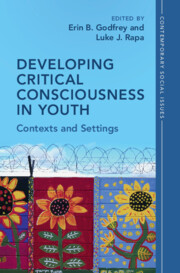Book contents
- Developing Critical Consciousness in Youth
- Contemporary Social Issues Series
- Developing Critical Consciousness in Youth
- Copyright page
- Dedication
- Contents
- Figures
- Tables
- Contributors
- Acknowledgments
- Introduction
- Part I Pedagogical, Curricular, and School-Based Contexts
- Part II Extracurricular Contexts
- 4 Re-envisioning the “Big Three” of Out-of-School Time Programs to Promote Critical Consciousness Development in Youth of Color
- 5 Breaking Down the Arts
- 6 “Listening is Where Love Begins” Advocacy for System-Impacted Youth as a Setting of Critical Consciousness Development
- Part III Societal Contexts
- Index
- References
5 - Breaking Down the Arts
A Novel Exploration of How Varying Kinds of Arts Participation Relate to Critical Consciousness among Youth of Color
from Part II - Extracurricular Contexts
Published online by Cambridge University Press: 11 May 2023
- Developing Critical Consciousness in Youth
- Contemporary Social Issues Series
- Developing Critical Consciousness in Youth
- Copyright page
- Dedication
- Contents
- Figures
- Tables
- Contributors
- Acknowledgments
- Introduction
- Part I Pedagogical, Curricular, and School-Based Contexts
- Part II Extracurricular Contexts
- 4 Re-envisioning the “Big Three” of Out-of-School Time Programs to Promote Critical Consciousness Development in Youth of Color
- 5 Breaking Down the Arts
- 6 “Listening is Where Love Begins” Advocacy for System-Impacted Youth as a Setting of Critical Consciousness Development
- Part III Societal Contexts
- Index
- References
Summary
Critical consciousness (CC) is a key tool for combatting injustice and has been associated with positive developmental outcomes for youth of color. Thus, it is crucial to identify the kinds of activities and settings that can facilitate youth’s CC. A small body of scholarship suggests that participation in social justice art (art that intentionally engages youth in addressing social injustice) can effectively build youth’s CC. Additionally, general art (art that does not intentionally address social injustice) has been associated with increased CC as well. However, further research is needed to understand how engagement in these two kinds of arts participation relate to each CC component, and whether certain art modalities (for example, music and dance) are more conducive to youth’s CC than others. A sample of 1,469 high school youth of color were included in this secondary analysis of data from the Stanford Civic Purpose Project (Damon, 2011–2013). Results from structural equation modeling suggest that different kinds of arts participation and modalities associate with CC in nuanced ways, revealing complexities in the relationship between arts programming and CC among youth of color. Findings point to the need to integrate a social justice focus into more traditional arts programming, with implications for youth’s engagement in the arts within school and out-of-school time settings.
- Type
- Chapter
- Information
- Developing Critical Consciousness in YouthContexts and Settings, pp. 122 - 154Publisher: Cambridge University PressPrint publication year: 2023



